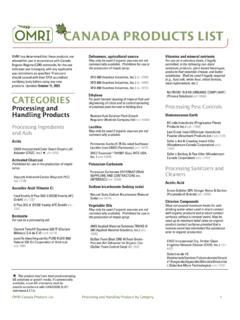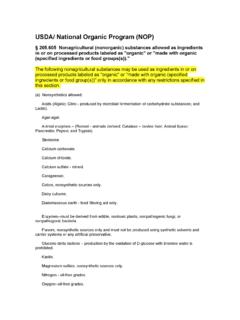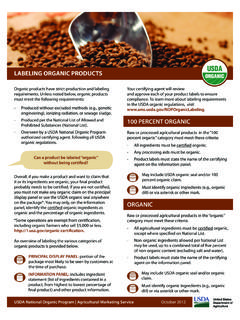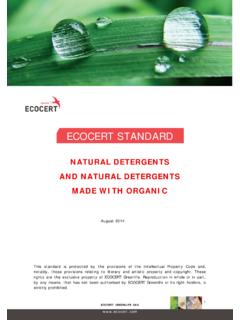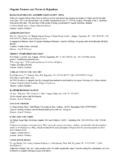Transcription of COR vs. NOP Standards - Organic Materials Review …
1 1 cor vs . NOP vs. NOP StandardsDifferences between Organic regulations of the Canadian General Standards Board (CGSB) and USDA s national Organic Program (NOP)CGSBCGSB ReferenceNOPNOP ReferenceCrop productionSoil amendments and crop nutrients shall not contain substances prohibited by par of , which includes all Materials and products produced from genetic and par. and products produced from genetic engineering may be used as soil amendments and crop nutrients with exceptions. See the OMRI Genetically Modified Organism (GMO) decision tree for more information about how OMRI reviews GMOs used in agricultural Materials are required to be Organic when used as inputs in crop production unless commercially unavailable in Organic form, , alfalfa meal and pellets, molasses, and oil seed Table Materials used as inputs in crop production are not required to be Organic .
2 However, they should not contribute to the contamination of crops, soil or & 203(c)Animal manure used for fertility in crop production must either be from an Organic farm or the animals must be able to turn in their pens and have access to light. In addition, application of manure has the 90/120-days to harvest par. application of raw manure is subject to the 90/120-days to harvest rule. There are no source (c)(1) & (2)Processed animal manure is not subject to specific processing parameters; operators must use best known practices to reduce human pathogens. Must meet the same source requirements as raw animal Table must be processed according to specific parameters (12% moisture and heated between 150 and 165 F for one hour) before it may be used without Guidance 5006 Aquatic Plant Products may be stabilized using sodium hydroxide or potassium hydroxide, but the manufacturer must prove the need to use sodium Table Plant Products may be extracted with sodium hydroxide and potassium hydroxide and the manufacturer does not have to prove the need to use sodium (j)(1)Ash from off-farm sources shall not exceed specific limits for acceptable levels of heavy metals.
3 See COR Supplement Review Standards for Lab Analyses for specific Table may not contribute to the contamination of crops, soil or water. OMRI has set thresholds where products may receive a caution flag or not be listed at all. (c) Blood is allowed only if sterilized and Bone meal may only be used if guaranteed to be free of specified risk Table products may not contribute to the contamination of crops, soil or water, but do not have source (c) Animal, animal products, and animal by-products used as compost feedstocks must be guaranteed free of specified risk Table products used as compost feedstocks are not subject to source restrictions. from off-farm sources shall not exceed specified maximum acceptable levels of trace contaminants and foreign matter for unrestricted use.
4 Compost produced on the farm has management practices/defined processing parameters, and must meet limits for acceptable levels of pathogens for unrestricted Table for compost produced off-site versus on the farm are the same. They include management practices/defined processing parameters. OMRI requires testing of finished compost to demonstrate compliance with compost (c)(1) & (2) and NOP Guidance 5 0 21 CGSB Canadian General Standards Board COR Canada Organic Regime NOP national Organic Program PSL Permitted Substances List This table is not an exhaustive list of differences between CGSB and NOP regulations. It is meant to provide examples and cover more general, large-scale cor vs .
5 NOP cor vs . NOP OMRICGSBCGSB ReferenceNOPNOP ReferenceEPA Environmental Protection Agency This table is not an exhaustive list of differences between CGSB and NOP regulations. It is meant to provide examples and cover more general, large-scale mulch, where Organic plant residue Materials are not readily available, non- Organic straw, leaves, grass clippings or hay that are not the products of genetic engineering may be used. Prohibited substances shall not have been used on these Materials for at least 60 days before Table is no required preference for Organic plant residues used as mulch, and residues of plants treated with prohibited substances may be used as mulch provided they are managed in a way that does not contribute to the contamination of crops, soil or water.
6 See the GMO Decision Trees in the OMRI Standards Manual . (b) & (c)(3) Plants and plant by-products: Wastes from crops that have been treated or produced with prohibited substances are prohibited as soil amendments. Plant by-products not meeting this restriction may be used as composting Table and par. from crops that have been treated or produced with prohibited substances are allowed for use as soil amendments. elements must be micronutrients from natural sources that are unchelated or chelated by substances listed as allowed. They are to be used when soil and plant deficiencies are documented by soil and plant testing. PSL Table micronutrients are not restricted. Synthetic micronutrients, except those made from nitrates or chlorides are permitted, but may only be used when soil deficiency is documented by testing.
7 & (j)(6)Worm castings must meet the limits for acceptable levels of human pathogens or the operator must demonstrate that best practices known to eliminate human pathogens during vermicomposting have been used. PSL Table with manure feedstocks must be made according to specific parameters, including that aerobic conditions be maintained by regular additions of layers of Organic matter, turning or employing forced air pipes such that moisture is maintained at 70-90%. NOP Guidance 5 0 21 Use of nonsynthetic ethyl alcohol is limited to use as a solvent to extract botanical Table alcohol use is not limited, and synthetic ethyl alcohol may be used as an algicide, disinfectant or cleaner, or as an adjuvant or inert ingredient in combination with permitted active pesticidal (a), (a)(1)Synthetic citric acid may be used as a chelating agent and pH adjuster.
8 PSL Table citric acid may be used to adjust the pH of liquid fish products. It may also be used for equipment cleaning provided there is no crop or soil contact. (j)(7)All use of copper is cautioned. No visible residue shall be allowed on harvested crops. PSL Table are specific limits on the use of copper sulfate in aquatic rice systems. (a)(3)Dormant oils are allowed as a dormant spray on woody plants only. PSL Table oils are not limited to use on woody plants. They must be narrow range oils and may be used as dormant, suffocating and summer (e)(7) & (i)(7)Formulants (inerts) permitted in pesticide formulations are classified by the Canadian Pest Management Regulatory Agency (PMRA) in Regulatory Note REP 2007-4 as List 4A or 4B.
9 Nonsynthetic inerts may also be Table ingredients permitted in pesticide formulations are classified by the Environmental Protection Agency (EPA) as 2004 EPA List 4a and (m)Plant extracts, oils and preparations may not be extracted by synthetic solvents except for potassium hydroxide or sodium hydroxide. The amount of solvent is limited to that necessary for extraction, and potassium hydroxide is preferred over sodium hydroxide. The manufacturer shall prove the need to use sodium hydroxide. PSL Table and sodium hydroxide may be used to extract aquatic plants only, and there is no preference for potassium over sodium hydroxide. (j)(1)3 cor vs . NOP cor vs . NOP OMRICGSBCGSB ReferenceNOPNOP ReferenceAAFCO American Association of Feed Control Officials NOSB national Organic Standards Board This table is not an exhaustive list of differences between CGSB and NOP regulations.
10 It is meant to provide examples and cover more general, large-scale feed and healthcareUse of anesthetics, sedatives and non-steroid anti-inflammatory analgesics ( ketoprofen) are allowed for minimizing pain, stress and suffering due to permitted physical Paragraph of medications, including anesthetics, sedatives, and non-steroid anti-inflamatory analgesics are only allowed if the active ingredient(s) are nonsynthetic or appear on for the specified use. (b)The use of synthetic medications that do not appear on the Permitted Substances List is allowed under certain circumstances and with certain restrictions. Paragraph medications may only be used if they appear on , , (b)Use of veterinary drugs not on the Permitted Substances List requires a withholding period that is double the label requirements before the products from the treated animal can be considered Organic .
